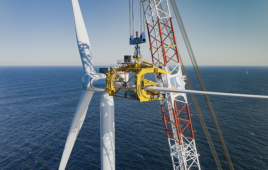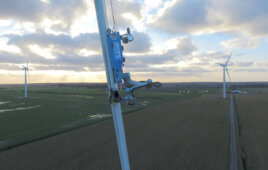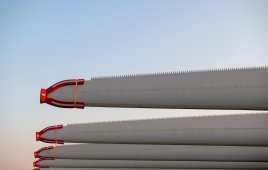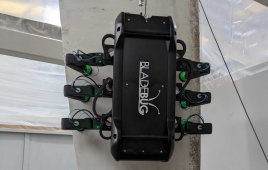What if a company redesigned the typically smooth blades on a turbine by adding a series of ridges, based on whale tubercles – bumps on humpback whale fins? WhalePower says its new blade design could increase annual electrical production for existing wind farms by 20%.

The idea is this: Humpback whales tilt their fins at steep angles for better lift in the water. Too much tilt, however, has the opposite effect—a loss of lift called stalling. Tubercles prevent stalling, allowing for more aggressive fin tilts. WhalePower’s tubercle-like structures on the turbine blades let blades work at steeper angles without stalling or creating too much drag. In low wind, blades with steeper angles theoretically generate more power. Wind tunnel tests published by WhalePower president and founder Frank Fish and Duke University fluid-dynamics expert Laurens Howle showed that, in some cases, adding tubercle-like bumps to model fins pushed back the stall angle by as much as 40%.
Testing on the tubercle-enhanced blades began in 2007 at The Wind Energy Institute of Canada in Prince Edward Island. A Canadian ventilation company, Envira-North Systems, will be the first to use tubercles on industrial fans.
Filed Under: Blades





Dear sir or madam,
I am Bin Wang at University of California, would like request permission of the figure in this report (bioinspied design from humpback whale fin) to be used in my advisor’s new book. Could you please reply to my email address (biw004@eng.ucsd.edu) so that I can tell you more about this and send you a permission form? Thank you in advance! Look forward to your reply!
we are making mini wind turbine designs in school and we are doing this for our porject.
i hope it works!!!
My organization, the Marine Science Institue is actively pursuing a new curriculum for our marine science programs which incorporates these bio inspired designs into a new relevant educational program!
Interesting,
if applied to aircraft this would mean thinner wings (less fuel) or higher angle on landings which means shorter, slower, safer landings, slower forward speed possible. Helicopters fly at extremely high angles of attack and are limited by stall/drag. Gyroplanes are essentially wind turbines with an aircraft attached, anyone aware of experiments with these?
Cameron:
I am not aware of studies on aircraft with the tubercles. The first applications will be on industrial overhead ventilation fans (16-ft diameters), in efforts to cut their power use.
Paul